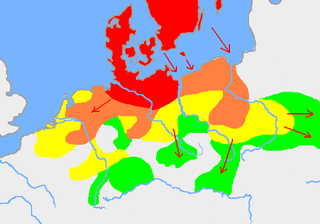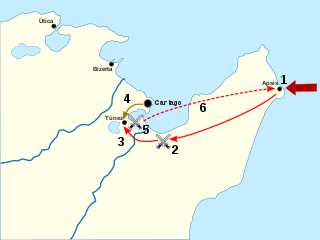Related Research Articles

The First Punic War was the first of three wars fought between Rome and Carthage, the two main powers of the western Mediterranean in the early 3rd century BC. For 23 years, in the longest continuous conflict and greatest naval war of antiquity, the two powers struggled for supremacy. The war was fought primarily on the Mediterranean island of Sicily and its surrounding waters, and also in North Africa. After immense losses on both sides, the Carthaginians were defeated and Rome gained territory from Carthage.
This article concerns the period 229 BC – 220 BC.
This article concerns the period 269 BC – 260 BC.
This article concerns the period 259 BC – 250 BC.
This article concerns the period 249 BC – 240 BC.
This article concerns the period 219 BC – 210 BC.

Year 250 BC was a year of the pre-Julian Roman calendar. At the time it was known as the Year of the Consulship of Regulus and Longus. The denomination 250 BC for this year has been used since the early medieval period, when the Anno Domini calendar era became the prevalent method in Europe for naming years.
Year 255 BC was a year of the pre-Julian Roman calendar. At the time it was known as the Year of the Consulship of Nobilior and Paullus. The denomination 255 BC for this year has been used since the early medieval period, when the Anno Domini calendar era became the prevalent method in Europe for naming years.

The Battle of Cape Ecnomus or Eknomos was a naval battle, fought off southern Sicily, in 256 BC, between the fleets of Carthage and the Roman Republic, during the First Punic War. The Carthaginian fleet was commanded by Hanno and Hamilcar; the Roman fleet jointly by the consuls for the year, Marcus Atilius Regulus and Lucius Manlius Vulso Longus. It resulted in a clear victory for the Romans.
Lucius Manlius Vulso Longus was a Roman general and statesman, who served as consul of the Roman Republic in 256 and 250 BC. He is remembered for his military successes; his military achievements, especially the Battle of Cape Ecnomus, significantly contributed to the victory of the Romans in the First Punic War.

The Battle of the Bagradas River, also known as the Battle of Tunis, was a victory by a Carthaginian army led by Xanthippus over a Roman army led by Marcus Atilius Regulus in the spring of 255 BC, nine years into the First Punic War. The previous year, the newly constructed Roman navy established naval superiority over Carthage. The Romans used this advantage to invade Carthage's homeland, which roughly aligned with modern-day Tunisia in North Africa. After landing on the Cape Bon Peninsula and conducting a successful campaign, the fleet returned to Sicily, leaving Regulus with 15,500 men to hold the lodgement in Africa over the winter.

The battle of Adys took place in late 256 BC during the First Punic War between a Carthaginian army jointly commanded by Bostar, Hamilcar and Hasdrubal and a Roman army led by Marcus Atilius Regulus. Earlier in the year, the new Roman navy had established naval superiority and used this advantage to invade the Carthaginian homeland, which roughly aligned with modern Tunisia in North Africa. After landing on the Cape Bon Peninsula and conducting a successful campaign, the fleet returned to Sicily, leaving Regulus with 15,500 men to hold the lodgement in Africa over the winter.
The Battle of Panormus was fought in Sicily in 250 BC during the First Punic War between a Roman army led by Lucius Caecilius Metellus and a Carthaginian force led by Hasdrubal, son of Hanno. The Roman force of two Roman and two allied legions defending the city of Panormus defeated the much larger Carthaginian army of 30,000 men and between 60 and 142 war elephants.

Marcus Atilius Regulus was a Roman statesman and general who was a consul of the Roman Republic in 267 BC and 256 BC. Much of his career was spent fighting the Carthaginians during the first Punic War. In 256 BC, he and Lucius Manlius Vulso Longus defeated the Carthaginians at the naval battle off Cape Ecnomus; afterwards he led the Roman expedition to Africa but was defeated at the Bagradas River in spring of 255 BC. He was captured and then probably died of natural causes.
Gaius Atilius Regulus was a Roman Republican consul who twice held the consulship in the middle of the 3rd century BC. He seems not to be closely related to M. Atilius M.f L.n. Regulus, for the grandfather of Regulus Serranus was named Marcus. Most likely the grandfathers were brothers and the successive consuls of 257 and 256 were second cousins.
The siege of Aspis or Clupea was fought in 256 BC between Carthage and the Roman Republic. It was the first fighting on African land during the First Punic War.
The Roman withdrawal from Africa was the attempt by the Roman Republic in 255 BC to rescue the survivors of their defeated expeditionary force to Carthaginian Africa during the First Punic War. A large fleet commanded by Servius Fulvius Paetinus Nobilior and Marcus Aemilius Paullus successfully evacuated the survivors after defeating an intercepting Carthaginian fleet, but was struck by a storm while returning, losing most of its ships.

The capture of Malta was the successful invasion of the Carthaginian island of Malta by forces of the Roman Republic led by Tiberius Sempronius Longus in the early stages of the Second Punic War in 218 BC.
Hasdrubal was a Carthaginian general who served during the middle years of the First Punic War, fought between Carthage and Rome, and took a leading part in three of the four major field battles of the war. He was a citizen of the city state of Carthage, which was in what is now Tunisia. His date of birth and age at death are both unknown, as are his activities prior to his coming to prominence in 255 BC. Modern historians distinguish him from other Carthaginians named Hasdrubal by the cognomen "son of Hanno".
References
- ↑ Casson, Lionel (1995). Ships and Seamanship in the Ancient World (1st ed.). Baltimore, Maryland: Johns Hopkins University Press. ISBN 0-8018-5130-0.
- ↑ "Clupea - Livius". www.livius.org. Retrieved December 1, 2022.
- ↑ Centre, UNESCO World Heritage. "The Great Wall". UNESCO World Heritage Centre. Retrieved December 1, 2022.
- ↑ Qian, Sima (1995). The Grand Scribe's Records, Vol. 1: The Basic Annals of Pre-Han China (1st ed.). Bloomington, Indiana: Indiana University Press.
- ↑ Zhang, Kan (2006). World Heritage in China. Guangzhou: The Press of South China University of Technology. ISBN 7-5623-2390-9.
- ↑ "Gaozu | emperor of Han dynasty | Britannica". www.britannica.com. Retrieved December 1, 2022.
- ↑ "Wuwang | ruler of Zhou | Britannica". www.britannica.com. Retrieved December 1, 2022.